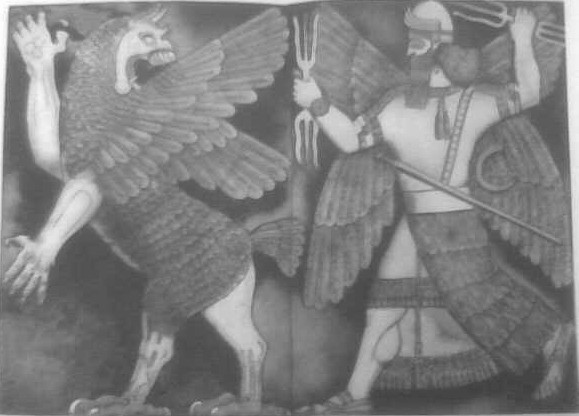Ancient tablets show Babylonians tracked Jupiter with geometry 1,400 years before Europeans
The ancient Babylonians used geometry to calculate the position of Jupiter 1,400 years before scholars in Europe were believed to have come up with the technique. The discovery is the earliest ever example of geometry being used to calculate positions of spacetime – and could indicate Western science was influenced by these ancient astronomers.
Mathieu Ossendrijver, a professor at Humboldt University in Berlin who specialises in Babylonian astronomy, made the discovery by studying five tablets dating to between 350 and 50 BC. He had long known of four of the tablets – but they were damaged, meaning he could not fully translate the information on them. He knew they involved geometrical computations, and thought they may involve Jupiter, but did not have enough information to go on to make any solid claims.

However, in 2015, he came across a set of photographs showing a previously unknown Babylonian astronomical tablet held at the British Museum in London. After examining it, he realised it related to the other four – acting as a key to unlock the information they contained. "The fifth one, was essential for forming a sense of the whole," he told IBTimes UK.
"All these questions were solved by this new tablet. Because it contains exactly the same computation in terms of numbers and it definitely deals with Jupiter. It was then possible to understand the others. It definitely deals with Jupiter. The trapezoid describes the motion of Jupiter. We were then able to reinterpret these tablets in spite of the fact they were damaged. It was a eureka moment."
Trapezoid

The tablets contain geometrical calculations based on a trapezoid's area, using its long and short sides. They showed the two intervals from when Jupiter first appears on the horizon, depicting it at 60 and 120 days. They also worked out the time when Jupiter has covered half the 60 day distance by positioning the trapezoid into smaller ones. The findings are published in the journal Science.
Ossendrijver said we already knew a great deal about the ancient Babylonians were advanced in terms of their mathematical and astronomical abilities. "But this bunch of tablets, this kind of geometry that we've now found, is another level of abstraction," he said. "It's a kind of geometry that is not found anywhere else in antiquity. It's geometrical objects in this trapezoid – essentially a rectangle with a slanted top. This trapezoid is not located in real space, like our 3D space in which we are living, in which the planets are moving. But it's found in a more abstract mathematical space. It describes how Jupiter's velocity changes with time.
"The horizontal axis is time, the vertical axis is velocity. This slanted topside which is orientated downwards represents how Jupiter's velocity decreases from day zero to day 60. So it's like a modern graph. This is totally new. We thought this was invented in 14<sup>th century in Oxford and Paris – groups of mathematicians were inventing these methods."
Why Jupiter?

Jupiter was particularly important to the Babylonians. The five tablets analysed were most likely found in Babylon and were written by astronomers who served as priests in the main temple. This temple was dedicated to Marduk, a god from ancient Mesopotamia patron deity of the city of Babylon. All of the gods were assigned a star or planet to represent – Marduk's was Jupiter.
Ossendrijver said it would have been no coincidence that five tablets with the same geometrical method dealt only with Jupiter and the same 60-day interval. While there is no evidence, he speculates that the priests would have had good reason to study Jupiter more intensely than the other planets. Whether Jupiter was used as a proof of concept, or whether they used this method to track the other planets is not yet known.
"I would like to think this method was also applied to other planets and maybe such tablets will be found one day. I simply don't know. It could be that it's one very clever astronomer who came up with this new method and he thought let's work it out with Jupiter and see where we go from there. Maybe it was not continued, or maybe we don't have the tablets that were produced after that for the other planets. Time will tell."
Complex society
While the Babylonians are known to have been very advanced, the latest find adds to the complexity and sophistication of their astronomy. It shows, Ossendrijver said, that they understood connections between time, velocity and distance travelled in a modern way – something he says is quite amazing.

How and why they were doing these calculations is unclear – researchers only have tablets with instructions on how to do something. There are no tablets explaining how they came up with something.
"These tablets are very rare or non-existent. So we can only speculate what they were actually thinking about with this method – how they perceived it. I like to think of the Babylonians as fully modern people that had the same cognitive skills as us, so I like to think that the astronomer who invented this was very proud of it or understood that it was something very new and very special."
Ossendrijver will continue to work with these other Babylonian astronomical tablets. He released his first book on them in 2012, and is currently in the process of writing a second that involves tables and numbers that describe positions in the sky.
Furthermore he is working with a colleague from Oxford to find links between the Babylonians and late Egyptian texts from the Roman period. The texts were found to have Babylonian astronomy relating to Mercury – showing their work had travelled to Egypt and the people there.
Summing up the latest research, astronomy historian John Steele of Brown University (who was not involved in the study), told Science Magazine Ossendrijver's finding was "an extremely important contribution to the history of Babylonian astronomy, and more generally to the history of science".
© Copyright IBTimes 2025. All rights reserved.






















